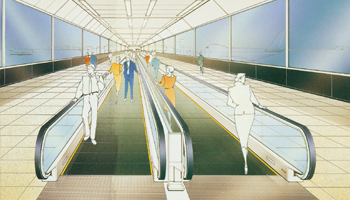News
Mitsubishi Electric Moving Walk:
Effortless Walk at a Faster Pace

Moving walks have a long history behind them and made their debut most notably in the form of special demonstration exhibitions at the Chicago Exposition of 1893 and the Paris Exposition of 1900. Today, they are commonly found in supermarkets, shopping malls, airports, and train stations all around the world since a moving walkway can become a good asset to any building or facility.
A solution to heavy foot traffic
The moving walkway was first an answer to the growing amount of foot traffic. This improves the experience of a passenger as compared to braving a walk, allowing them to travel with ease and without the frustration of bumping against pedestrians walking at different paces. This also answers congestion problems during the pandemic — the need to distance yourself from other people to lessen the virus transmissions.
Places for moving walks
Airports and shopping malls are some of the main places to find moving walks. This is because of the efficiency it can bring to transport passengers at a much quicker and smoother pace.
The moving walk doesn’t have to always be on a flat surface. An inclined one, as seen in superstores, can help shoppers easily move between floors while carrying their shopping carts. This means that they wouldn’t need to use the elevator just to get to different floors.
Finding a moving walkway for your building
Having a moving walkway can be just what your building needs to take that customer experience a notch higher. Functional enough to meet your building’s foot traffic flow needs and versatile enough to fit any aesthetic, moving walks are the way to go.
Mitsubishi Electric offers an array of moving walks in both horizontal and inclined system configurations. By utilizing basic structural technologies equivalent to those of our escalators, high reliability, durability, safety and cost performance are ensured.

